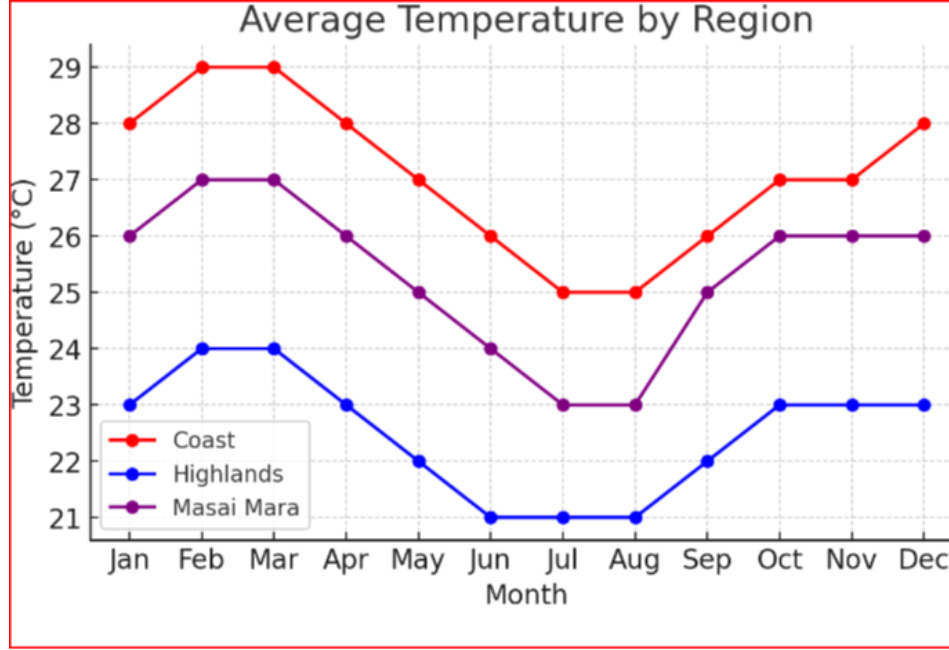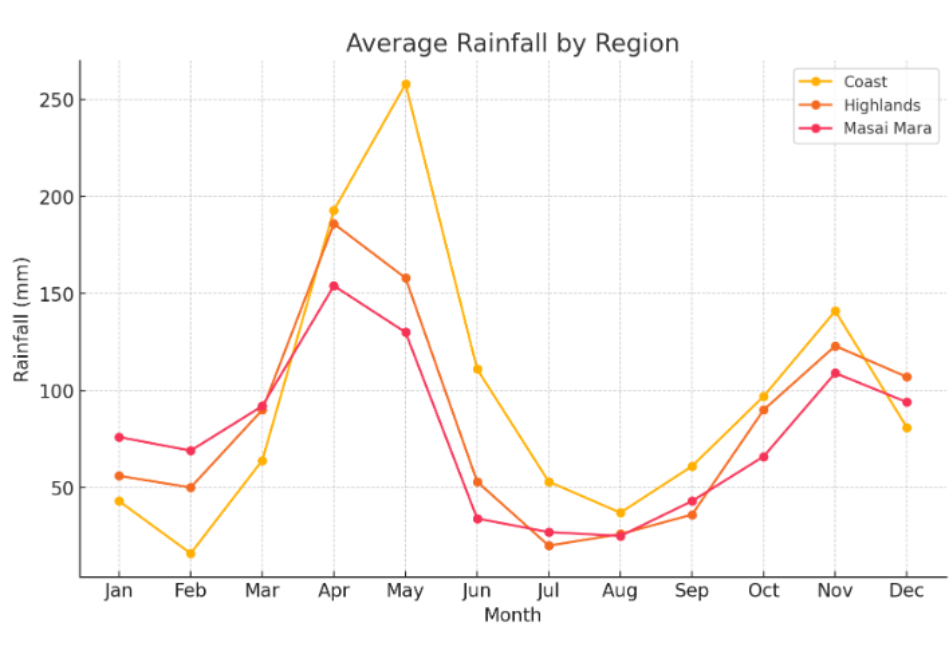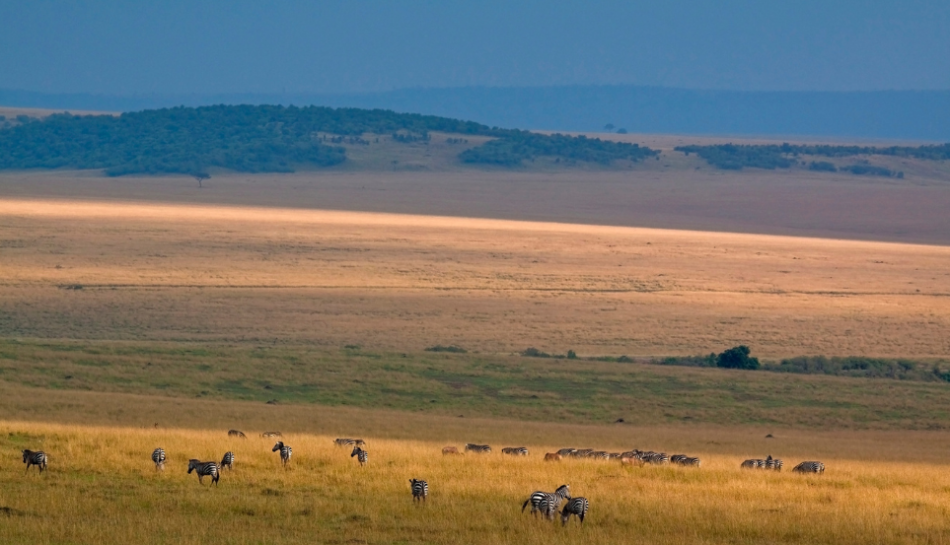Kenya is a land of incredible diversity, not only in its landscapes and wildlife but also in its weather. The country's geography spans coastal regions, highland areas, expansive savannahs, and arid deserts, creating significant climatic variations. Understanding these regional weather patterns is important for planning a memorable safari experience. Whether you're exploring the tropical coast, the cool highlands, or the iconic savannahs like the Masai Mara, each region offers unique weather conditions that can significantly impact your travel plans.
Weather in the Coastal Regions of Kenya
Kenya's coastal areas, stretching along the Indian Ocean, are characterized by a tropical climate. This region includes popular destinations like Mombasa, Malindi, and Diani Beach. The weather here is warm and humid year-round, with temperatures typically ranging from 24°C (75°F) to 30°C (86°F). The coast is influenced by the oceanic climate, resulting in a distinct pattern of wet and dry seasons.
Seasonal Weather Patterns
-
Long Rains (April to June): This period marks the long rainy season. The coastal region receives heavy rainfall, often accompanied by thunderstorms. The humidity levels are high, but the ocean breezes provide some relief, making the temperatures more bearable than the inland areas.
-
Short Rains (October to November): The short rainy season is less intense than the long rains. Rainfall is generally lighter and more sporadic, with occasional sunny days. This period is characterized by a lush, green landscape and a flourishing marine ecosystem, ideal for snorkeling and diving enthusiasts.
-
Dry Seasons (July to September and December to March): The dry seasons are characterized by warm and sunny weather, making them the peak tourist periods. These months are perfect for enjoying the pristine beaches and engaging in water sports. The temperatures remain fairly consistent, rarely dropping below 24°C (75°F).
Ideal Time to Visit the Coast
The best time to visit Kenya's coastal regions is during the dry seasons, from July to September and December to March. These months offer pleasant weather for beach activities, clear skies for marine excursions, and less humidity. However, if you're interested in experiencing the vibrant marine life, the short rainy season can be rewarding, as it coincides with the breeding season of various marine species.
Weather in the Highlands and Mountain Regions of Kenya
The central highlands of Kenya, including Nairobi and the areas surrounding Mount Kenya, experience a mild climate due to their higher elevation. The altitude plays a significant role in moderating temperatures and creating a distinct weather pattern compared to the lower coastal regions.
Climate Characteristics
-
Temperature Range: The temperatures in the highlands range from 10°C (50°F) to 26°C (79°F). The higher altitude means cooler temperatures, especially in the mornings and evenings. Nairobi, the capital city, often experiences a temperate climate, making it comfortable for year-round exploration.
-
Rainy Seasons: The long rains in the highlands occur from March to May, bringing heavy downpours and cooler temperatures. The short rains follow from October to December. These periods are characterized by lush landscapes, ideal for trekking and exploring Kenya's coffee and tea plantations.
-
Dry Seasons: The dry season, from June to September and January to February, offers cooler and drier conditions. This is the best time for outdoor activities such as hiking in the Aberdare Range or exploring the Nairobi National Park.
Best Time to Visit the Highlands
The highlands can be visited year-round, but the dry season (June to September and January to February) is particularly favorable. The cooler temperatures make it ideal for exploring urban and rural highland attractions without the discomfort of heavy rains. The clear skies during this time also provide spectacular views of Mount Kenya.
Weather in the Masai Mara Region
The Masai Mara, one of Kenya's most iconic safari destinations, is located at an elevation of approximately 1,500 meters (5,000 feet) above sea level. This elevation provides a more temperate climate, making it a comfortable destination for wildlife enthusiasts.
Climate Overview
-
Temperature Range: The Masai Mara experiences mild daytime temperatures ranging from 20°C (68°F) to 30°C (86°F). Nights and early mornings can be quite cool, with temperatures dropping to around 10°C (50°F) to 12°C (54°F). It's advisable to bring layers for the cooler evenings.
-
Rainy Seasons: The Masai Mara has two rainy seasons. The long rains occur from April to June, bringing rejuvenation to the landscape and a burst of new life as many animals give birth. The short rains, from October to November, are less intense but still provide essential moisture to the ecosystem.
-
Dry Seasons: The dry seasons, from July to October and December to March, are the best times for game viewing. During these periods, the vegetation is less dense, making it easier to spot wildlife. The dry conditions also force animals to congregate around water sources, offering excellent opportunities for sightings.
The Great Migration
One of the most significant events in the Masai Mara is the Great Migration, occurring from July to October. During this time, millions of wildebeest, zebras, and gazelles move from the Serengeti in Tanzania to the Masai Mara, crossing the Mara River. This spectacle is a highlight for visitors, offering dramatic scenes of river crossings and predator-prey interactions.
Best Time to Visit the Masai Mara
The ideal time to visit the Masai Mara is during the dry season, particularly from July to October, when the Great Migration takes place. This period offers optimal wildlife viewing conditions, with cooler weather and abundant animal sightings. However, the short rainy season in November can also be a good time to visit, as the park is less crowded and the landscape is lush and green.
Graphs and Charts: Visualizing Kenya's Weather Patterns
To provide a clearer understanding of Kenya's diverse climate, the following graphs illustrate the average temperature and rainfall patterns across different regions.
Average Temperature by Region

This chart illustrates the monthly temperature variations across the Coast, Highlands, and Masai Mara regions. The coastal region remains consistently warm throughout the year, while the highlands experience cooler temperatures due to their higher altitude. The Masai Mara also has a moderate climate, with temperatures staying relatively mild.
Average Rainfall by Region

This chart shows the average monthly rainfall for the same regions. The coastal region receives significant rainfall, especially during the long rainy season from April to June. The highlands also experience substantial rainfall, particularly during the long rains. The Masai Mara has a distinct wet and dry season pattern, with notable rainfall during the long rains and lower rainfall during the dry seasons.
In conclusion, Kenya's diverse climate means there is no single "best" time to visit; rather, the ideal time depends on your interests and the specific experiences you seek. Whether you're chasing the Great Migration in the Masai Mara, exploring the cool highlands, or soaking up the sun on the tropical coast, Kenya offers a unique and unforgettable adventure year-round.
Key Considerations for Planning Your Safari
-
Wildlife Viewing: For optimal wildlife viewing, particularly if you're interested in the Great Migration, plan your visit during the dry season from July to October. The dry conditions make animals more visible, and the cooler temperatures are ideal for game drives. The least favourable season for safari is between April and May, as heavy rains can sometimes make the roads challenging to navigate.
-
Beach Holidays: For a relaxing beach holiday, the dry seasons on the coast (July to September and December to March) are perfect. These months offer constantly sunny days, without rains.



